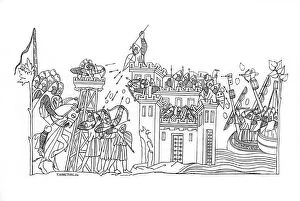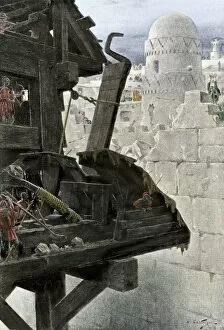Siege Machine Collection
"Unleashing the Fury: A Glimpse into the World of Siege Machines" Step back in time to witness the chaos and destruction of a siege scene
For sale as Licensed Images
Choose your image, Select your licence and Download the media
"Unleashing the Fury: A Glimpse into the World of Siege Machines" Step back in time to witness the chaos and destruction of a siege scene, captured by artist Henry Shaw in c1260. With his intricate brushstrokes, he brings to life the relentless battle between attackers and defenders within an ancient fortress. Plate 14 takes us on a thrilling journey as we witness a new attack on an old fortress during The War of the Romans Against. . What secrets lie behind those towering walls? Will victory be claimed or lost? In Plate 12, Torquato Tasso's Gerusalemme liberata transports us to another era, where Leonardo da Vinci himself sketched designs for awe-inspiring siege machines. Marvel at his ingenuity as he envisions contraptions that could change the course of history. But it is not just artists who have delved into this world; historians too have uncovered fascinating relics from our past. Bombarding a Fort in Saxon Times (c1934) showcases how even centuries ago, mankind sought innovative ways to breach fortifications and claim victory. Engine for throwing stones (1870) reveals yet another ingenious creation born out of necessity. Witness how these early engineers harnessed technology to launch projectiles with deadly accuracy. Returning once again to Shaw's masterful artistry, we find ourselves amidst another intense siege scene from c1260. Feel your heart race as you imagine being caught up in this tumultuous clash between armies vying for control over strategic strongholds. Shaw's depiction also offers us a glimpse into specific siege machines employed during these battles. From trebuchets hurling boulders through the air to battering-rams relentlessly pounding against fortified gates – each device played its part in shaping history. And let us not forget catapults used in ancient times. These powerful weapons were capable of launching projectiles great distances with astonishing force – forever changing warfare as we know it.












